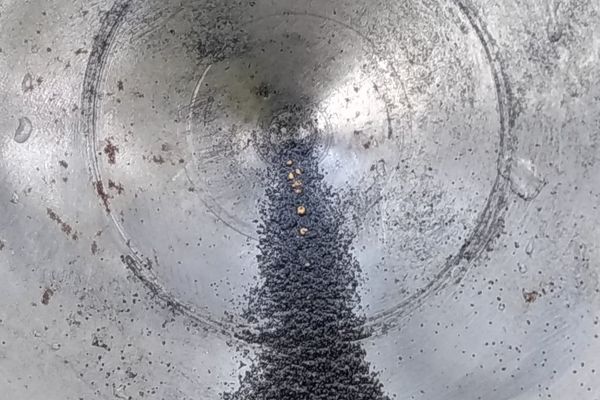Throughout the summer, the Auvergne Volcan Sancy Tourist Office offers outings on the theme of gold panning. What if you, too, put yourself in the shoes of a gold digger, in a territory that conceals many mineral treasures.
It’s not the “Gold Rush” but it may sound like it. Throughout the summer period, the Auvergne Volcan Sancy Tourist Office offers activities for tourists on the theme of gold panning. Several half-day outings are scheduled each week. Céline Barrat, mountain guide and nature coordinator within Auvergn’attitude, has been leading these outings for 3 years: “ We go to the edge of a river called the Burande, in the town of Singles. We welcome people and I explain to them what we are likely to find. We look at sample boxes so that people get used to the grain size, and that they see that what we are looking for is really very small “. She continues: “On then goes to the riverside. I give a demonstration: I explain to them where we take the alluvium, how we use the beat. Then, each participant has a beat and it is left for gold panning: everyone tries to search. We also have small magnifying glasses, we try to define what we can find, either gold, or sapphires, zircons, olivine. When we manage to extract them, we put them in a box ».
You have to be very persevering or even stubborn
But don’t expect to make a fortune on these outings: “ Sometimes we find sapphires. When we find gold, it is more of the order of spangles. I think we put a lot of them in the stream because it’s really small and very often we don’t see them. Quite frequently we find small Auvergne sapphires: they are translucent blue minerals. “. The facilitator indicates: ” You have to be very persevering, even stubborn. You have to use the beat for a long time and have some learning. It is necessary to wash the alluvium well, to bring out the largest grains. We must arrive as far as a very fine black sand called magnetite, which will end up at the bottom of the drive. It is in this very fine sand that we will find gold, if we have to find any. Alluvium is collected on the bank, which is what is carried by the river. We wash them and put them in a batter, an instrument that looks like a Chinese hat. We wash these alluvium well. We put the beating on the water and we operate a circular movement. This brings out the large alluvium, as if under the effect of a small centrifuge. This movement is repeated and the materials are concentrated at the bottom of the beat. We turn, we wash, we arrive at this famous magnetite in which we hope to find gold. We meet other people doing gold panning in the river ».
An old gold mine
The Burande site was not chosen at random: “ There is long-standing gold panning at La Burande. History says that there was a gold mine upstream of this river, at a place called “Old Bridge”. We always hope that with the rains and thunderstorms, the river carries small remains, thanks to a rise or a descent of the water and that it leaves them in the alluvium on the banks. This gold mine was a gold concession that closed at the beginning of the 20th century “. More than a quest for wealth, tourists are mainly looking for a fun activity: “ We are in the shade with our feet in the water in a river. We have to admit that when it’s really hot, that’s where we are best. There is also a whole imagination of the search for gold. It recalls the conquest of the West. We imagine ourselves as a gold digger. We welcome families and children. If you find something to be adventurous, it’s time to party within the group. The best take is a nice little sapphire. There are small semi-precious diamonds, which still have an effect ».
On the Burande river, in Singles, in the Puy-de-Dôme, you can look for gold flakes.
•
© Laurent Dufour
–
The wealth of the Massif Central
Auvergne is a territory which can contain treasures. “ On the scale of the metropolis, there are regions such as Brittany, the Massif Central, the Vosges, which are richer in metals and minerals. In geology, they are called ancient massifs »Explains Nicolas Charles, geologist at BRGM (Bureau of geological and mining research). Historically, it is near Tour-d’Auvergne and Bort-les-Orgues in Corrèze that we find the first traces of gold mining in Auvergne: ” In terms of gold, the Bessette site is interesting from an archaeological point of view. It was one of the first Gallic aurières to be discovered and studied in France. It is a gold vein which was partially exploited by the Gauls. They also exploited the eluvia, that is to say the dismantling of this vein in the immediate vicinity. This means that one can potentially find something on this site. In Roman times, Gaul was known as “Gallia aurifera”. This was one of the motivations for the Roman invasion. The Gauls were excellent miners. In the writings, we speak of galleries, trenches, holes built by the Gauls. After the Gauls, it must have been exploited during the Middle Ages and it resumed during the 17th century, but it is linked to questions of political stability in these regions. Currently, we are talking about a gold index for geologists, there is nothing economical on this site ».
In Auvergne, there are only small clues, that is to say that if we wanted to exploit it, it would not be profitable
Today, only faint traces of gold are found: “ In Auvergne, there are only small clues, that is to say that if we wanted to exploit it, it would not be profitable. Nearby, in Creuse, there is the Châtelet mine. Historically about 11 tonnes of gold have been mined. It affects Auvergne. In Cantal, there are a few small clues in the heart of the department. There are some in the Jordanne valley, where gold panning is done. But it remains anecdotal from an economic point of view. We will not find more than gold glitter. It remains anecdotal “. A physical phenomenon can explain the presence of gold in the rivers of Auvergne. Nicolas Charles indicates: ” You have to keep in mind that there are primary and secondary deposits. The primary deposits were formed at depth, often in veins, and it is hydrothermal. These are warm waters that will precipitate minerals, including quartz. In this quartz, gold will be trapped. There is gold and sulphides. Gold is either microscopic, or sometimes it can be seen with the naked eye, trapped in quartz. Once in the open air, the rocks are subjected to climatic elements, with a phenomenon of weathering. The quartz vein will start to crumble. You are going to have blocks, pebbles, gravel. These small grains of quartz follow the slopes, and will go into the hydrographic network, that is to say the rivers. These erosion products will be transported to rivers. The quartz grains will decrease and the gold is put in solution, dissolved in water. When glitter and in rare cases nuggets are found, the gold which is in solution will precipitate around the pebble. This is called the pepitization phenomenon. Gold calls for gold. When we are going to start this little gold bud, another gold will come and settle on it ».
The scientific explanatione
The geologist underlines how the artisanal miners proceed: “ Gold is very dense, 19 times heavier than water. In nature, heavy minerals are deposited quite quickly, especially deep in the river bed. All the interest of the gold miner is to find where the gold is deposited, by density. In rivers, we will rather go to meandering areas, where the current slows down. It is necessary to privilege the part which is above the U formed by the meander. This is where we have the most alluvial deposits, the products transported by rivers, gravel and sands. The gold is going to be trapped there. When we take gold, we take sand, with small minerals. We do it on the fly. The objective of the drive is to concentrate the heaviest elements at the bottom of the tool. Gold is what we see last at the bottom of the hike ».

Gold flakes appear at the bottom of the beat after some effort.
•
© Laurent Dufour
–
The presence of other metals
But gold is not the only precious metal that can be found in Auvergne: “ There is a stream near Rochefort-Montagne, the Sioulot. Small sapphires can be found on the fly. But it’s very small, one or two millimeters. It is linked to the presence of volcanic rocks which trapped sapphires while forming. Olivine is often found in basalts, the emblematic rock of Auvergne. Zircons can also be found within rocks. The Loire has its source in Auvergne. In the Loiret, some people have fun hiking, towards Gien and Sully-sur-Loire and find sapphires that come from Auvergne. It’s still very small, millimeter-scale minerals. There’s no way to make a fortune “. Auvergne contains other riches: ” In Auvergne, diatomites are still exploited for their industrial interest. It is a sedimentary rock that contains diatoms. It is exploited towards Murat. It is used as a filter agent in industry. In Auvergne, there are deposits of European size ”.

:quality(80)/cdn-kiosk-api.telegraaf.nl/13d0faf4-e0d6-11eb-a0f8-02c309bc01c1.jpg)
